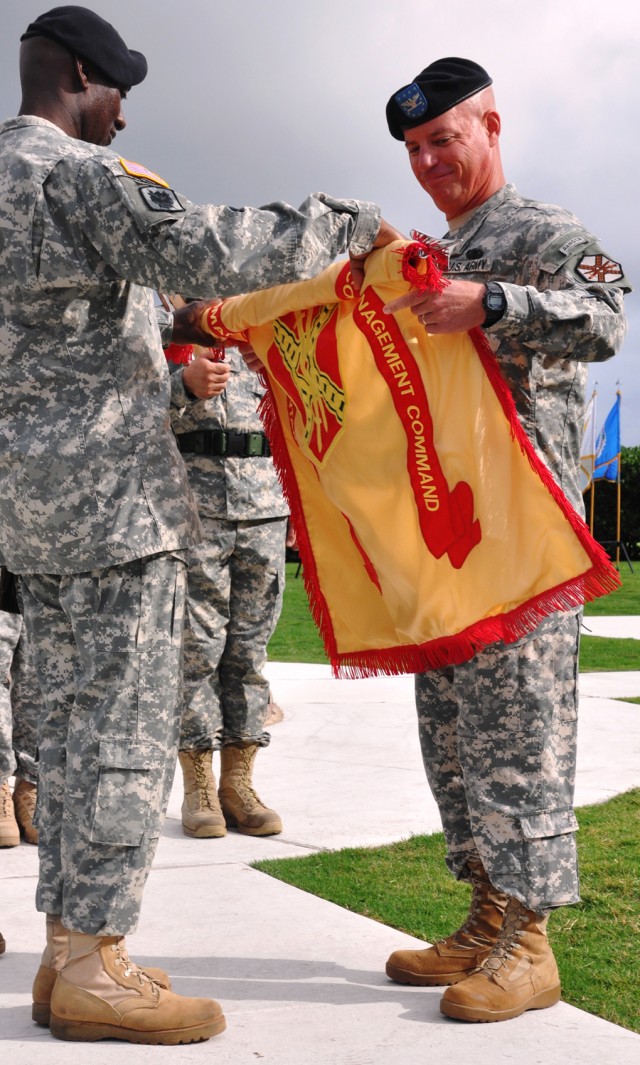FORT SAM HOUSTON, Texas -- In a move that further solidifies Fort Sam Houston's growing reputation as the place to be, the U.S. Army Environmental Command uncased its colors in a ceremony at the post flagpole May 21.
The transfer of the command is in accordance with 2005 Base Realignment and Closure directives and brings an additional 200 military and civilian jobs to the San Antonio area.
According to Army tradition, when a unit or the headquarters of a unit undergoes a permanent change of station, the colors are "cased" - literally furled and placed inside a canvas case - to signify that the command has ceased operations at that location. The colors are then "uncased" at the new location to signify that the command is operational at its new station.
The mission of the USAEC, which has been located at the Aberdeen Proving Ground in Maryland for 38 years, is to lead and execute environmental programs and provide environmental expertise that enables Army training, operations, acquisition and sustainable military communities.
The command is also the first of the Installation Management Command's two subordinate commands (which includes the Family and Morale, Welfare and Recreation Command) to move to San Antonio. In addition, IMCOM's headquarters will also soon be located at Fort Sam Houston. These remaining units are scheduled to complete the transfer by September 2011.
"The transition of the USAEC flag from Aberdeen to San Antonio is such an important event. It's a great big deal," said Lt. Gen. Rick Lynch, IMCOM commanding general and the Army's assistant chief of staff for installation management. "This is signified by today's placement of the colors and today is the first of many. All this shows that IMCOM is moving this way," the general said. "The very fact that I can present a Texas flag to Colonel Kimmell shows you how excited we are to be coming to Texas."
In talking about the importance of the command's mission, Lynch referred to Thomas Friedman 2008 book, "Hot, Flat and Crowded."
"When the Army goes green, the nation will go green," the general quoted from the book. "The nation has to go green to preserve our future. We have to be moving towards energy independence and security."
The USAEC's move to Fort Sam Houston seems especially appropriate as the post recently won a Lone Star Land Steward Award in the special recognition category from the Texas Parks and Wildlife Department for its work in preserving and working with the environment at its massive combat medic training area at Camp Bullis.
"I couldn't be prouder to be the first USAEC commander at Fort Sam Houston and unfurl my team's colors, signifying this historic place as our new home," said USAEC Commander Col. Scott D. Kimmell. "We have a wonderful history at Aberdeen Proving Ground in Maryland, and we are ready to start a new chapter at Fort Sam Houston.
Taking the reins of USAEC just 15 days earlier when the colors were cased in Maryland, Kimmell is responsible for addressing environmental challenges that face the Army, including Soldier training to modern standards, base closure and realignment construction, installation cleanup and growth of the force.
A brigade-level subordinate command, USAEC provides central planning, management, coordination, oversight, and technical support to the Army's environmental programs. Kimmell's duties will include restoration of contaminated lands; pollution prevention; technology transfer; reporting and tracking of Army environmental programs; conservation of natural and cultural resources; and compliance with environmental standards and criteria set by laws and regulations.
"We come with a seemingly simple, but very important, mission for our Army - to make sure we lead and execute environmental programs and provide expertise that allows our Army to train, conduct operations, support acquisitions and provide sustainable military communities for our workforce and our Families," said Kimmell.
"We're always focused on the Soldier and readiness," the colonel added. "The team responsible for this extremely important mission is comprised of the best professionals our country has to offer - Soldiers and civilians with talents in environmental science, preservation, geology, botany and chemistry, to name a few. We are armed to the teeth technically to ensure our Soldiers and their Families have a safe place to work and live.
"Establishing our colors here is only the tip of the iceberg of the great things to come," said Kimmell, who added that about 30 percent of the USAEC workforce is currently in San Antonio and the rest should be here by July 2011. "Our IMCOM headquarters will soon follow us to Texas, thus firmly planting the leadership of IMCOM in San Antonio.
"We are an Army in transition and at war," the colonel said. "However, we are resilient and we will continue to ensure that our Soldiers, Families, civilians have a safe place to train, grow and live."
The colonel said one of the added benefits of moving to San Antonio was the great Tex-Mex food available here and he let on a little information that's sure to make him popular with the locals.
"It's great to come from Washington, D.C., to Texas, especially as a Dallas Cowboy fan," Kimmell said with a smile. "We love the area and are just so happy to be here.
Lynch echoed the sentiment, saying, "My wife is from Killeen, I've got 16 years at Fort Hood, and I claim Texas."


Social Sharing